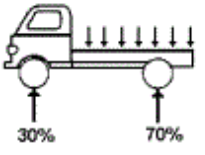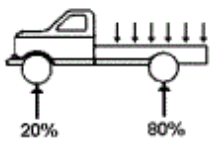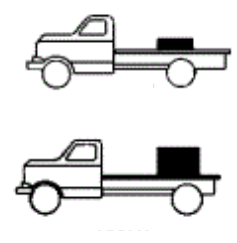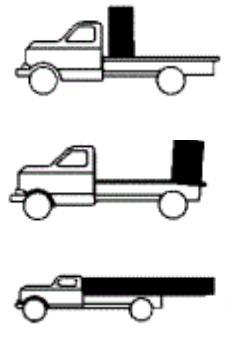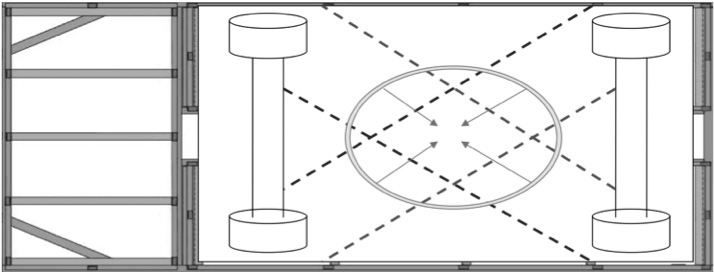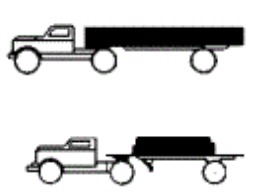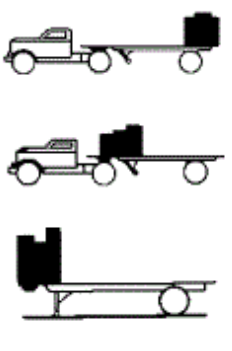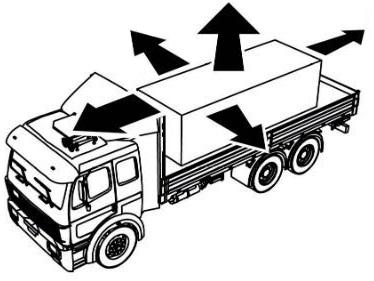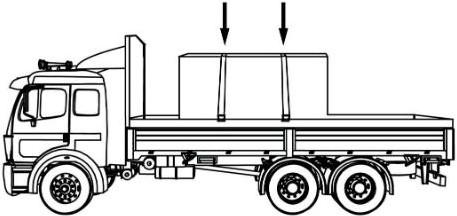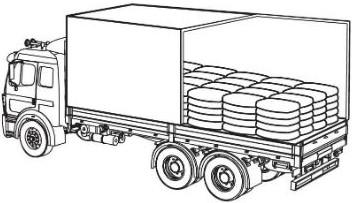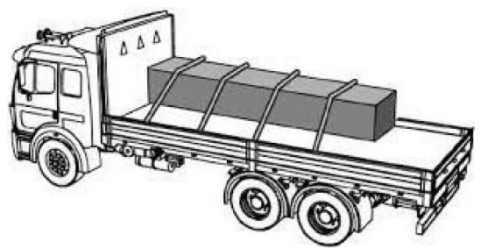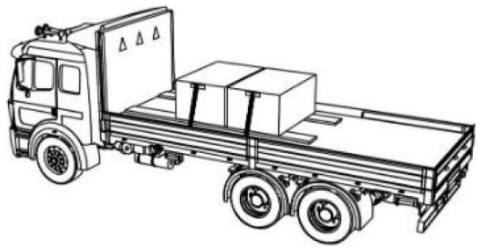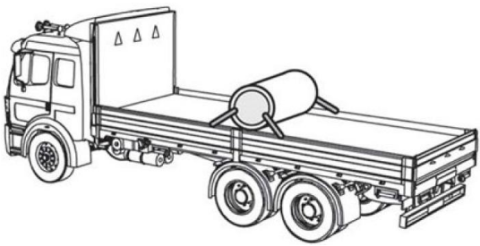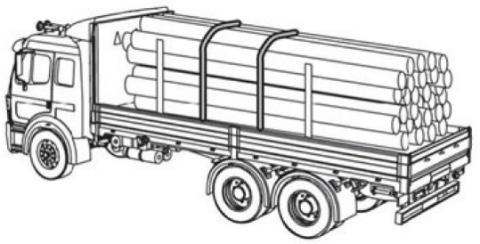Loading Vehicles
Unlike sea or air cargo transportation, humanitarian actors will almost certainly be involved with the direct loading of cargo vehicles at some point. Loading of cargo onto a truck may appear fairly straight forward, however there are several things that shippers may need to consider. Frequently, third-party transport companies and private vehicle hires may understand the loading needs of their own vehicles, but in the event agencies are self-managing loading or the third-party service does not have the capacity to mange loading, organisations may have to - and possibly be legally required to - take responsibility for securely loading vehicles.
The overall balance of the load on the bed or cargo hold of any truck varies based on the body, while the overall weight limits of each of the vehicles varies based on the vehicle itself – prior to planning a cargo load, it is strongly advised to research the type of vehicle to avoid accidents.
Single unit or conventional trucks are designed to carry 70-80% of cargo weight over the rear axle, balancing the load of the cargo against the weight of the cab.
When loading cab over engine or conventional pickup trucks with heavy cargo loads, start above the rear axle with weight distributed just before the axle towards the centre of the bed. Loads pushed too close to the cab can obscure the rear view of the driver, will increase the distance required to break, and may reduce traction to the road due to uneven weight distribution. Loads pushed too far to the rear will be more unstable and can also cause problems with traction. Loads sticking far off the rear of a smaller truck should be avoided whenever possible – excessively long loads not only cause weight imbalance to the vehicle, but may be hazardous to other vehicles and passengers.
Tractor / trailer configuration trucks are designed to keep cargo weight centred between the two axles. When loaded to a tractor weight should be evenly distributed in the centre of the bed, while trailers without a truck may be loaded with weight slightly moved towards the rear axle.
When planning a load on a trailer, consider the “X” planning strategy – if a line is drawn between each of the wheels where they make contact with the road, where the two lines intersect to form an “X” is where the centre of gravity for any cargo load should go.
"X" configuration:
When loading all vehicle types, ensure that cargo weight is also centred in along the short edge of the bed as well. Cargo weight too far to one side or another can lead to instability in the vehicle, impacting turning or even leading to vehicles tipping over.
In all loading configurations, planners and loaders should consider:
- Always load the heaviest items at the bottom of the items stacked onto a truck bed. Top heavy loads are more likely to fall over in transit.
- Loaders should plan for weight to be evenly distributed on all four sides of a truck bed. Even if space is properly utilised, overly heavy cargo on one side of the vehicle will cause issues while in transit.
Weight in Movement
Cargo on the back of a vehicle can be heavy or bulky, and while drivers may understand the overall weight of the vehicle while stopped or at low speeds, increased speed can cause the weight of the cargo to act on the vehicle in unintended ways. Forces acting on the cargo during transport are caused by different movements made by the vehicle. The acting forces are:
- Deceleration
- Acceleration
- Centrifugal force (outward)
- Gravity
- Vibration
These forces may cause sliding, tipping and wandering. Cargo loads should always be properly secured, and vehicles should take extra caution when going around corners, going over bumps or small hills, or when starting or stopping.
Cargo Tie-Downs
Any place where a rope or chain passed over cargo and is secured to both sides of the vehicle is referred to as tie-down.
A general guide for how many tie-downs to use can be seen below:
| Number of Tie-Downs | Length of Load | Weight of Load |
|---|---|---|
| 1 | Shorter than 1.5 meters | Less than 500 kg |
| 2 | Shorter than 1.5 meters | Greater than 500 kg |
| 2 | Longer than 1.5 meters but shorter than 3 meters | - |
| 3 | Longer than 3 meters but shorter than 6 meters | - |
| 4 | Longer than 6 meters but shorter than 9 meters | - |
| 4 (at least) | - | Greater than 4,500 |
| 5+ | Additional tie-down for every additional 3 meters gained after 9 meters |
Typical loads of cartons and basic relief supplies can be secured using nylon rope, however extremely heavy equipment such as generators or vehicle should be secured using chains. The best way to gauge the strength of a series of chain tie downs to secure a load is what is known as the “working load limit” (WLL). WLL is measured by combining the WLL of each individual chain or rope used as a tie down. As an example, if a load is secured with four chains with a WLL each of 500 kgs, the TOTAL WLL for that load is 2,000 kgs.
To properly design a WLL for transport of heavy or bulky cargo, the total WLL of all tie-downs should be at least half the weight of the load itself. As an example, if a truck is transporting a generator that weighs 3,000 kgs, the combined WLL of all the securing chains should be at least 1,500 kgs. The WLL on the tie-downs accommodates for shifts in weight as the truck turns, stops or accelerates, shifting the centre of gravity of the heavy load.
Chains are measured in both their size and their grade:
- Size - The diameter of the metal "wire" in the link.
- Grade - The stress a chain is designed to break at.
A general guide to WLL per chain type can be seen below.
| Working Load Limit (WLL) in Kilograms (kgs) per Grade and Chain Size | |||||
|---|---|---|---|---|---|
| Chain Size (cm) | Grade 30 | Grade 43 | Grade 70 | Grade 80 | Grade 100 |
| 0.6 | 500 | 1,100 | 1,400 | 1,500 | 1,850 |
| 0.8 | 900 | 1,800 | 2,200 | 2,100 | 2,600 |
| 0.95 | 1,200 | 2,550 | 3,000 | 3,200 | 4,000 |
| 1.1 | 1,600 | 3,200 | 3,900 | - | - |
| 1.25 | 1,900 | 4,000 | 5,000 | 5,400 | 6,700 |
| 1.6 | 3,150 | 5,900 | 7,200 | 8,250 | 10,300 |
Whether shipping cartons or oversized bulky items, there are recognised loading and securing methods to minimise accidents and damage to cargo.
Cartons / sacks – when loading cartons or sacks into the bed of a truck, avoid stacking in pyramid or forming piles. Cartons and sacks should be stacked in even rows, as low to the bed of the truck as possible. Stacks should be arranged in interlocking "brick” format to avoid stacks from coming apart, and where possible, stacks of cartons or sacks should be secured with netting, tarp or rope, especially if the truck bed has no sides or bars.
Bulky items – bulky items such as timber, generators, or other large equipment should be firmly secured to bed of a truck using rope or chain of appropriate strength.
A quick reference guide to cargo load securing can be downloaded here.


